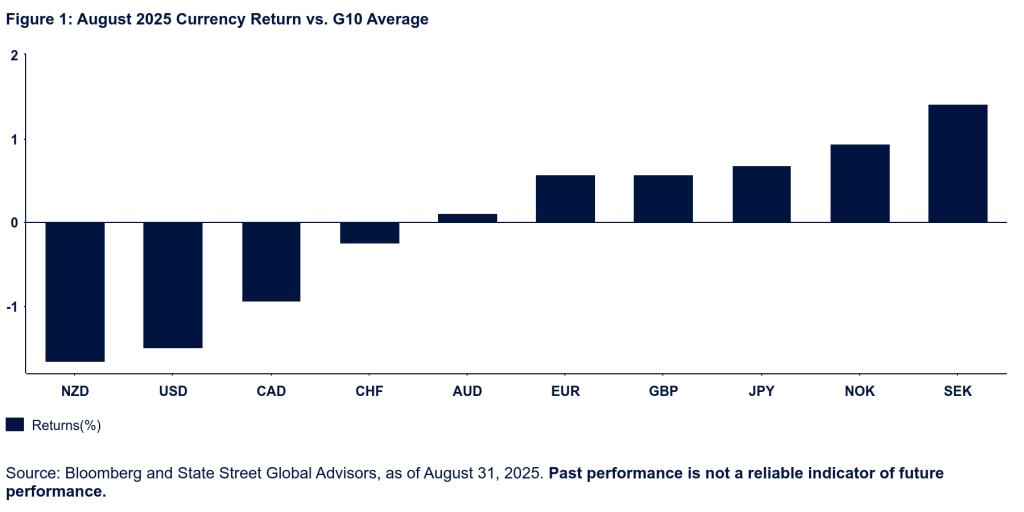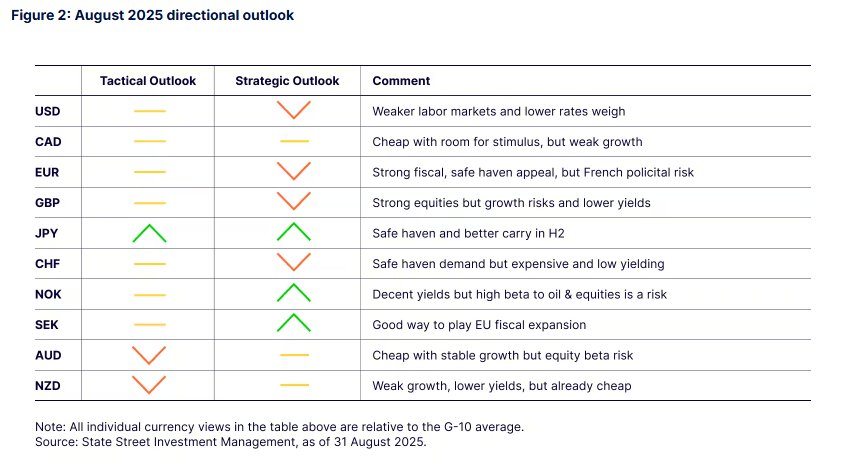By: Aaron R Hurd, FRM, Senior Portfolio Manager
Slowing US labor markets, tariffs, and an impending Fed easing cycle weigh on the dollar, adding to our bearish outlook. Investors are turning to the euro and yen as safe havens amid rising global uncertainty and currency market volatility.
Federal Reserve (Fed) rate cuts have lifted equity market sentiment. However, monetary easing driven by a weaker growth outlook does not provide a stable foundation for risk assets. The combination of a softening economic backdrop, easier monetary policy, persistent tariff measures, and geopolitical uncertainty is likely to create pockets of heightened volatility in riskier assets over the near term.
Given this environment, a cautious stance may be warranted over the next 04 August to 04 October. Traditional safe-haven currencies such as the Japanese yen, euro, and Swiss franc could offer value. The yen may remain under pressure until markets gain clarity on the Liberal Democratic Party (LDP) leadership following Prime Minister Ishiba’s resignation. Once resolved, the yen is likely to emerge as the primary beneficiary of the anticipated US monetary easing cycle.

Political developments in Europe also warrant attention. The French no-confidence vote and ongoing concerns about UK fiscal spending are likely to keep debt sustainability top of mind for currency investors. In this context, the Swedish krona stands out due to its strong government debt profile and positive exposure to increased EU fiscal spending.

Looking further ahead, we favor short US dollar positions against currencies with:
- Positive net international investment positions,
- Strong fiscal and monetary flexibility,
- Historically attractive valuations versus the US dollar.
On these criteria, the Japanese yen, Swedish krona, and Norwegian krone appear to be top performers. The Australian dollar, euro, Canadian dollar, and British pound should also post solid gains against the US dollar, in that order. Conversely, the Swiss franc is most at risk of underperforming the US dollar, particularly when considering total return metrics that include its negative interest rate carry.
US Dollar (USD)
We expect another round of weak US jobs data, first in early August and again on 05 September, to push US yields and the dollar lower over the next 04 October to 04 November. Softer growth and declining rates support a sustained monetary easing cycle and a weaker currency outlook.
However, we anticipate the dollar’s decline will be gradual, not a return to the steep downtrend seen earlier this year. Several factors support this view:
- US growth and consumption remain resilient compared to other major economies, despite labor market softness and rising consumer debt delinquencies.
- Tariff-driven inflation is likely to keep the Fed on a slower easing path than it would otherwise pursue, assuming similar labor market deterioration.
- US equities continue to outperform global peers.
The dollar is already weaker than it was at the start of the year. Notably, despite the employment shock and the Fed’s dovish pivot, the Bloomberg Dollar Index has traded in a tight 1% range (1200–1210) since 04 August, suggesting that a fair amount of pessimism is already priced in, for now.
We maintain our call for a multi-year US dollar bear market, expecting a decline of at least 15% over the next 2–4 years. While the US remains a strong destination for capital investment, thanks to its innovative companies and dynamic labor and capital markets. We believe the degree of US economic outperformance will be materially smaller, and the dollar’s reliability as a safe haven will be materially weaker over the next 10–15 years compared to the previous decade.
The BEA’s net international investment position report shows that non-US investors hold over USD33 trillion in US portfolio investments and more than USD62 trillion in total US investments, excluding financial derivatives. Even a modest 10% increase in average US dollar hedge ratios would imply over USD3 trillion in dollar sales, more than enough to fuel a prolonged US dollar bear market, even if the US remains among the top-performing economies.
Canadian Dollar (CAD)
We anticipate continued weakness in the Canadian dollar relative to the G10 average, with some downside expected against the US dollar as well. The sharp deterioration in Canadian growth is particularly concerning, especially given that most Canadian exports remain exempt from US tariffs. Our expectation that US growth will also slow adds further drag to the Canadian economy. The Bank of Canada is very likely to cut rates again in September, and further easing may be necessary later this year or early next. This environment does not bode well for the Canadian dollar.
One mitigating factor is that, with the US labor market softening and the Fed poised to ease rates, the Canadian dollar may hold up better against the US dollar than other G10 currencies. While USD/CAD may test the low 1.40s from its current level of 1.38, a sustained uptrend is less likely due to the downward fundamental pressures on the US dollar.
Looking ahead, we are more constructive on the Canadian dollar over the medium term. By our long-run fair value measures, the Canadian dollar is undervalued. We expect the North American tariff dispute to eventually lead to a renegotiated United States-Mexico-Canada Agreement (USMCA) that preserves favorable relative tariffs for North America compared to the rest of the world. Canada also has greater capacity for swift monetary and fiscal stimulus than the US, along with room for deregulation and expanded trade with countries outside North America.
As clarity emerges around tariffs and the USMCA, and the Fed resumes rate cuts, we see scope for USD/CAD to fall into the low 1.30s by 2026. Over the longer term, consistent with our broader US dollar bear market thesis, we expect USD/CAD to trade below 1.20. However, the Canadian dollar is likely to remain sluggish against the G10 excluding the US, as the weak US dollar itself acts as a headwind.
Euro (EUR)
We hold a neutral to slightly positive view on the euro over the next 1–2 months relative to the G10 currencies. Political uncertainty, particularly the no-confidence vote threatening French Premier Bayrou’s leadership, is likely to cap near-term euro gains. However, French fiscal risks appear to be well priced and are relatively muted at the broader EU level.
At the same time, slowing US labor markets point to weaker US growth, while tariff-related drag continues to weigh on most global economies. This backdrop introduces risk to equity markets and tends to favor currencies like the euro, which benefits from a current account surplus and typically performs well during periods of heightened asset volatility. The euro’s safe haven appeal is further supported by improved relative EU yields, as higher-rate countries ease policy more aggressively than the European Central Bank, which is either done easing or very close to it. Together, these factors create a reasonably supportive environment for a resilient euro.
Looking further ahead, we remain constructive on the euro. The region is supported by strong household balance sheets, low unemployment, and positive real wage growth. Additional tailwinds include increased defense spending and the proposed €500 billion German infrastructure fund. These developments strengthen the case for euro appreciation over the medium term.
Moreover, as the US becomes a less reliable trade and security partner, the incentive for EU investors to reduce their concentrated exposure to US assets, or at least increase their average currency hedge ratios is growing. We see scope for EUR/USD to move toward 1.35 over the next 3–5 years.
That said, the euro’s outlook against other G10 currencies is less optimistic. It remains expensive relative to the Japanese yen, Norwegian krone, Swedish krona, and Australian dollar, and is likely to underperform these currencies in the coming years, especially once tariff-related growth risks and equity market volatility begin to subside.
British Pound (GBP)
We maintain a neutral stance on the British pound relative to the G10 average, though we see risks tilted to the downside. Recent upside surprises in growth and employment offer some support and may allow for a modest recovery in sterling over the coming weeks. However, this strength rests on a fragile foundation. The UK continues to grapple with high debt levels, persistent current account deficits, and the looming threat of stagflation. The now-delayed autumn budget, expected in late November, adds to the uncertainty, especially given the country’s pronounced fiscal constraints.
While unemployment stabilized in July, the rate remains at a four-year high, and the trajectory points to further weakness. The combination of elevated debt and inflation limits the flexibility of both monetary and fiscal policy to respond effectively to downside economic surprises. This leaves the UK economy and the pound in a vulnerable position.
That said, against the US dollar, we expect the pound to stabilize in the low to mid 1.30s this year. Over a longer horizon of 3 to 5 years, we see potential for the pound to appreciate toward the 1.45–1.50 range. Additionally, we expect the pound to outperform the expensive and low-yielding Swiss franc over the coming years on a total return basis.
Japanese Yen (JPY)
Our models have turned increasingly positive on the Japanese yen, and we believe the recent negative US employment data sets the stage for yen strength over the next 1–2 months. As yield differentials compress in Japan’s favor, the yen stands to benefit. Slower US and global growth, combined with seasonal factors, raise the likelihood of increased volatility in risky assets conditions under which the yen’s safe haven appeal typically strengthens.
Domestically, Japan’s inflation remains well above target, while retail sales and PMI data point to resilient economic momentum. The 15% tariff appears manageable, and the recent selloff in the yen has cleared out many bullish positions, creating a more favorable technical setup.
However, a last-minute revision to our outlook is warranted. Last night, Prime Minister Ishiba announced plans to resign, introducing a layer of political uncertainty that may weigh on the currency in the near term. The initial market reaction has been yen-negative, driven by concerns over higher fiscal spending and the possibility that a new government might pressure the Bank of Japan (BoJ) to maintain ultra-low interest rates.
We view any politically driven yen weakness as a buying opportunity. The fiscal concerns seem overstated Japan’s debt is domestically financed, and the government has flexibility to avoid issuing long-duration bonds. Moreover, increased fiscal spending could support growth and strengthen the case for further rate hikes. While a new administration may encourage the BoJ to proceed cautiously, we expect this to delay rather than derail future tightening.
Ultimately, our bullish yen view is anchored more in expectations for US rates to fall by at least 100–125 basis points. That dynamic is likely to be a far more powerful driver of yen appreciation than any potential 25–50 basis point adjustment from the BoJ.
Swiss Franc (CHF)
We expect the Swiss franc to materially underperform other G10 currencies going forward. By our estimates of long-run fair value, it is currently the most expensive currency in the G10. It also carries the lowest yields and inflation among its peers, making it particularly vulnerable in a global environment shaped by deflationary shocks including those stemming from tariffs, even if partially mitigated through negotiation.
In response to these pressures, we anticipate that the Swiss National Bank (SNB) will become more open to direct intervention in currency markets to weaken the franc later this year and into next. There is also a possibility that the SNB may be forced to reintroduce negative policy rates, although we believe such a move would require a meaningful deterioration in consumer price inflation. On a total return basis, the increasingly negative interest rate carry associated with long franc positions makes it difficult to envision the franc outperforming its G10 counterparts. Even against the US dollar, the franc would need to appreciate by at least 10–15% over the next 3–5 years just to offset the drag from its negative carry.
Additionally, we do not expect portfolio rebalancing away from the US dollar over the next 1–3 years to benefit the franc as much as it might other currencies. Swiss investors already hedge a large portion of their foreign exchange exposure, which limits the scope for increased US dollar hedge ratios. In simpler terms, there is less room for additional US dollar selling and franc buying, reducing the potential upside for the currency.
Norwegian Krone (NOK)
We hold a neutral to slightly negative view on the Norwegian krone over the next 1–2 months. Norway’s national balance sheet remains exceptionally strong, which is a significant advantage in a global environment marked by fiscal concerns and rising term premiums. Additionally, with the Fed expected to resume its rate-cutting cycle, Norwegian yields are likely to remain among the most attractive in the G10 even if Norges Bank cuts rates once or twice before year-end.
However, two key concerns temper our near-term outlook. First, oil markets face pressure from increased OPEC+ production, which could weigh on prices, especially if global demand softens under the strain of tariffs and slower economic growth. Second, the risk of renewed equity market volatility remains elevated as the world navigates a period of heightened policy and economic uncertainty. Historically, the krone has shown vulnerability to such volatility, and we see potential for periods of significant swings in the currency despite our broadly neutral stance.
Looking further ahead, we are more constructive. The krone is historically undervalued relative to our estimates of fair value and is supported by Norway’s steady long-run growth potential and robust fiscal position. The country also possesses ample monetary and fiscal flexibility to cushion the long-term impact of the current tariff shock. We believe the krone is setting up for solid gains once we move past peak tariff tensions, reprice risky assets and oil, and begin to focus on tariff reductions and renewed stimulus efforts.
Swedish Krona (SEK)
Our outlook for the Swedish krona is modestly positive over the next 1–2 months. As a small, open economy with a relatively less liquid currency, Sweden is likely to experience greater downside volatility in the near term due to the tariff shock and its drag on regional growth. However, with the Fed poised to cut rates, interest rate differentials are expected to shift in Sweden’s favor, offering some support to the krona.
While growth remains sluggish, it is showing signs of stabilization. Sweden also stands out as a compelling way to gain exposure to potential EU fiscal stimulus, particularly in light of concerns surrounding French debt. The country’s material exposure to the defense sector and its comfortable debt-to-GDP ratio of 33% further strengthen its macroeconomic position. On a real effective basis, the krona is historically undervalued, adding to its appeal.
Sweden’s fiscal and monetary flexibility, combined with the potential for gradual portfolio rebalancing, also supports the currency. The large foreign asset holdings in both Sweden and the broader EU present scope for a shift away from the US dollar. Even if this shift materializes primarily through higher US dollar hedge ratios, it could still provide a meaningful tailwind for the krona.
Australian Dollar (AUD)
Our tactical models have turned slightly negative on the Australian dollar in the near term. There are several headwinds to consider. The outlook for a durable US–China trade agreement remains uncertain, and domestically, Australia continues to face challenges such as subdued business investment, elevated household debt servicing burdens, and what appears to be a structural slowdown in productivity growth. We expect the effects of a slowing US economy and the broader global drag from tariffs to become more visible in economic data over the next couple of months. This, combined with a seasonal tendency for increased equity market volatility, is likely to weigh on commodity prices and cyclically sensitive currencies like the Australian dollar.
That said, our negative view is tempered by several supportive factors. Inflation has picked up, GDP growth has improved, PMI data has strengthened, and labor market conditions remain solid. These developments provide a foundation for a medium-term recovery in the currency.
Over the longer term, we are considerably more positive on the Australian dollar. It remains significantly undervalued relative to our estimates of fair value. While growth has been modest, it has shown resilience, as evidenced by stronger household consumption and robust services sector performance. Australia also retains ample fiscal and monetary policy space to cushion the long-term impact of elevated tariffs.
Additionally, Australian investors appear to hold a high proportion of unhedged US dollar-denominated assets. We believe this exposure is likely to be reduced over time, either through increased currency hedge ratios or a broader reallocation toward more diversified global portfolios. As the global economy adjusts to the new tariff regime, we see meaningful potential for a long-term rally in the Australian dollar.
New Zealand Dollar (NZD)
Our tactical model has shifted to a modestly negative view on the New Zealand dollar in the near term. While improved retail sales and stronger manufacturing PMI suggest a gradual recovery, significant economic slack remains. The unemployment rate stands at 5.2%, matching pandemic-era highs.
New Zealand is largely insulated from direct US tariffs, but it will likely experience indirect drag as growth headwinds emerge across Asia. External demand is unlikely to provide meaningful support. We expect the RBNZ to ease policy further, potentially lowering rates to 2.5% or below in the coming quarters, a notably low level for a country with a moderate fiscal deficit and a current account deficit near 6%.
Additionally, the New Zealand dollar’s historically high sensitivity to global risk sentiment makes it vulnerable in this period of heightened economic and policy uncertainty.
Our long-term view on the New Zealand dollar is mixed. On one hand, the currency appears undervalued relative to our fair value estimates against the US dollar and Swiss franc, suggesting room for appreciation. On the other hand, it remains expensive compared to the Japanese yen and Scandinavian currencies.
Originally posted on September 19, 2025 on SSGA blog
PHOTO CREDIT: https://www.shutterstock.com/g/fmcginn
VIA SHUTTERSTOCK
DISCLOSURES:
State Street Global Advisors Worldwide Entities
State Street Global Advisors (SSGA) is now State Street Investment Management. Please go to statestreet.com/investment-management for more information.
Investing involves risk including the risk of loss of principal. All material has been obtained from sources believed to be reliable.
There is no representation or warranty as to the accuracy of the information and State Street shall have no liability for decisions based on such information.
Currency Risk is a form of risk that arises from the change in price of one currency against another. Whenever investors or companies have assets or business operations across national borders, they face currency risk if their positions are not hedged.
The views expressed in this material are the views of Aaron Hurd through the period ended 31/08/2025 and are subject to change based on market and other conditions. This document contains certain statements that may be deemed forward-looking statements. Please note that any such statements are not guarantees of any future performance and actual results or developments may differ materially from those projected.
This document may contain certain statements deemed to be forward-looking statements. All statements, other than historical facts, contained within this document that address activities, events or developments that SSGA expects, believes or anticipates will or may occur in the future are forward-looking statements. These statements are based on certain assumptions and analyses made by SSGA in light of its experience and perception of historical trends, current conditions, expected future developments and other factors it believes are appropriate in the circumstances, many of which are detailed herein. Such statements are subject to a number of assumptions, risks, uncertainties, many of which are beyond SSGA’s control. Please note that any such statements are not guarantees of any future performance and that actual results or developments may differ materially from those projected in the forward-looking statements.
The information provided does not constitute investment advice and it should not be relied on as such. It should not be considered a solicitation to buy or an offer to sell a security. It does not take into account any investor’s particular investment objectives, strategies, tax status or investment horizon. You should consult your tax and financial advisor.
The information contained in this communication is not a research recommendation or ‘investment research’ and is classified as a ‘Marketing Communication’ in accordance with the Markets in Financial Instruments Directive (2014/65/EU) or applicable Swiss regulation. This means that this marketing communication (a) has not been prepared in accordance with legal requirements designed to promote the independence of investment research (b) is not subject to any prohibition on dealing ahead of the dissemination of investment research.
This communication is directed at professional clients (this includes eligible counterparties as defined by the “appropriate EU regulator”) who are deemed both knowledgeable and experienced in matters relating to investments. The products and services to which this communication relates are only available to such persons and persons of any other description (including retail clients) should not rely on this communication.
All information is from SSGA unless otherwise noted and has been obtained from sources believed to be reliable, but its accuracy is not guaranteed. There is no representation or warranty as to the current accuracy, reliability or completeness of, nor liability for, decisions based on such information, and it should not be relied on as such.
The trademarks and service marks referenced herein are the property of their respective owners. Third party data providers make no warranties or representations of any kind relating to the accuracy, completeness or timeliness of the data and have no liability for damages of any kind relating to the use of such data.
The whole or any part of this work may not be reproduced, copied or transmitted or any of its contents disclosed to third parties without SSGA’s express written consent.
The whole or any part of this work may not be reproduced, copied or transmitted or any of its contents disclosed to third parties without SSGA’s express written consent. Whenever investors or companies have assets or business operations across national borders, they face currency risk if their positions are not hedged. Past performance is not a reliable indicator of future performance. Assets may be considered “safe havens” based on investor perception that an asset’s value will hold steady or climb even as the value of other investments drops during times of economic stress. Perceived safe-haven assets are not guaranteed to maintain value at any time.



